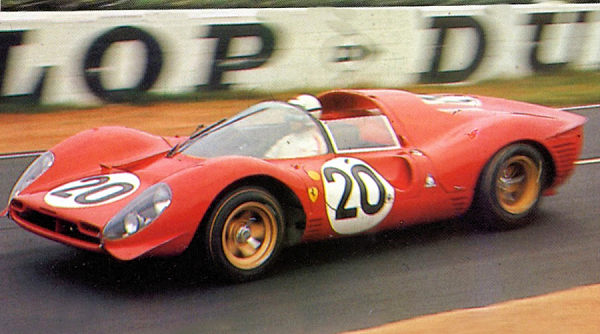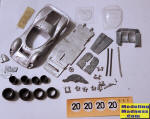
FDS 1/43 Ferrari 330P4
| KIT #: | 109 |
| PRICE: | $25.00 or so 'used' |
| DECALS: | One option plus two for the OS2Us |
| REVIEWER: | Scott Van Aken |
| NOTES: | Cast metal multimedia kit |

| HISTORY |
1967 was a banner year for the Enzo Ferrari motor company, as it saw the production of the mid-engined 330 P4 a V12-engined endurance car intended to replace the previous year's 330 P3. Only four Ferrari P4-engined cars were ever made: three new 330 P4s and one ex P3 chassis (0846). Their three-valve cylinder head was modeled after those of Italian Grand Prix-winning Formula One cars. To this was added the same fuel injection system from the P3 for an output of up to 450 hp (335 kW).
The P3 won the 1000 km Monza in 1966, and the P4 won the same race in 1967. Two P4s, and one 412 P crossed the finish line together (in first 0846, second 0856, and third place 0844) in the 1967 24 Hours of Daytona, for a photo finish to counter Ford's photo of the Ford GT40 Mk.II crossing the finish line together First, Second, and Third at the 1966 24 Hours of Le Mans.
Since then, the fate of these four cars has been the subject of much attention.
0846. Built in 1966 as the first of 3 works 330 P3s and the only P3 Spyder. Retained by the works at the end of 1966 and used as the basis for the new P4 and partially converted to P4 specification for 1967. Ferrari states 0846 no longer exists. It was decided by the factory to scrap the chassis due to its previous accident history and fire damage sustained at Le Mans, 1967. The original chassis number has been written off Ferrari's books as an existing chassis, but the number is still in their ownership.
0856 was originally built as a Berlinetta but converted by the factory into a Spyder for Brands Hatch, 1967 as it remains today. Currently in Canadian ownership.
0858 was originally a Berlinetta but converted by Ferrari into a Spyder for Brands Hatch, 1967 and later in the year converted into a 350 Can-Am by them. Now fitted with a P4 Berlinetta body and is in German ownership.
0860 was also originally a Berlinetta and converted to a Spyder for Brands Hatch, 1967 and like 0858 converted by Ferrari to a 350 Can-Am but was fitted with a P4 Spyder body in the early 1970s by its then French owner in whose family it remains today.
| THE KIT |
 I first really started getting interested
in racing sports cars in the mid 1960s. These were the years of the Cobras,
Ford GT-40s, Lolas and, of course, a variety of Ferraris. Ferrari had always
fielded cars in road races both in the US and Europe as well as other
places. These cars were generally evolutionary improvements over the ones
before with changes in chassis dynamics, engine displacement, and body
design. It is the body design of the 330 P4 that, for me, is the main
attraction. It is sleek and smooth and just looks fast sitting still. This
was in the very early days of modern aerodynamics on cars and the most you'd
find is a small spoiler on the back and some small fences on the nose to
help hold it down at speed. Many cars after this went for the wedge look and
lost their sleekness and style. You only have to look at the monstrosities
that are called racing cars today to see what I mean.
I first really started getting interested
in racing sports cars in the mid 1960s. These were the years of the Cobras,
Ford GT-40s, Lolas and, of course, a variety of Ferraris. Ferrari had always
fielded cars in road races both in the US and Europe as well as other
places. These cars were generally evolutionary improvements over the ones
before with changes in chassis dynamics, engine displacement, and body
design. It is the body design of the 330 P4 that, for me, is the main
attraction. It is sleek and smooth and just looks fast sitting still. This
was in the very early days of modern aerodynamics on cars and the most you'd
find is a small spoiler on the back and some small fences on the nose to
help hold it down at speed. Many cars after this went for the wedge look and
lost their sleekness and style. You only have to look at the monstrosities
that are called racing cars today to see what I mean.
Overall, the casting is pretty good. All the parts will need clean-up and some areas on the body have dimples and small trenches that will benefit from some filler. The metal axles are pretty soft metal and have a rather rough surface as if they have rust on them. You can probably figure out what most of the parts are. There is a long cast metal piece next to the axles that is the windscreen support as this kit is the Spyder version. The two large bits with small notches are rear inner wheel wells while the smaller ones are for the front. Next to the front corner of the body are two small air dams on a single casting. The exploded view instructions do not show these being used, though they were. The decal sheet has markings for the #20 car at LeMans in 1967
| CONCLUSIONS |
| REFERENCES |
Back to the Main Page Back to the Previews Index Page
Back to the Previews Index Page